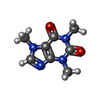+Search query
-Structure paper
| Title | Cryo-EM analysis of scorpion toxin binding to Ryanodine Receptors reveals subconductance that is abolished by PKA phosphorylation. |
|---|---|
| Journal, issue, pages | Sci Adv, Vol. 9, Issue 21, Page eadf4936, Year 2023 |
| Publish date | May 24, 2023 |
 Authors Authors | Omid Haji-Ghassemi / Yu Seby Chen / Kellie Woll / Georgina B Gurrola / Carmen R Valdivia / Wenxuan Cai / Songhua Li / Hector H Valdivia / Filip Van Petegem /     |
| PubMed Abstract | Calcins are peptides from scorpion venom with the unique ability to cross cell membranes, gaining access to intracellular targets. Ryanodine Receptors (RyR) are intracellular ion channels that ...Calcins are peptides from scorpion venom with the unique ability to cross cell membranes, gaining access to intracellular targets. Ryanodine Receptors (RyR) are intracellular ion channels that control release of Ca from the endoplasmic and sarcoplasmic reticulum. Calcins target RyRs and induce long-lived subconductance states, whereby single-channel currents are decreased. We used cryo-electron microscopy to reveal the binding and structural effects of imperacalcin, showing that it opens the channel pore and causes large asymmetry throughout the cytosolic assembly of the tetrameric RyR. This also creates multiple extended ion conduction pathways beyond the transmembrane region, resulting in subconductance. Phosphorylation of imperacalcin by protein kinase A prevents its binding to RyR through direct steric hindrance, showing how posttranslational modifications made by the host organism can determine the fate of a natural toxin. The structure provides a direct template for developing calcin analogs that result in full channel block, with potential to treat RyR-related disorders. |
 External links External links |  Sci Adv / Sci Adv /  PubMed:37224245 / PubMed:37224245 /  PubMed Central PubMed Central |
| Methods | EM (single particle) |
| Resolution | 2.84 - 3.84 Å |
| Structure data | EMDB-27680, PDB-8drp: EMDB-27695, PDB-8dtb: EMDB-27721, PDB-8duj: EMDB-27736, PDB-8dve: |
| Chemicals |  ChemComp-CFF:  ChemComp-ATP:  ChemComp-ZN:  ChemComp-CA: |
| Source |
|
 Keywords Keywords |  MEMBRANE PROTEIN / MEMBRANE PROTEIN /  Ryanodine receptor / Ryanodine receptor /  Ion channel / Snake toxin / Calcin / Ion channel / Snake toxin / Calcin /  Complex / Complex /  TOXIN TOXIN |
 Movie
Movie Controller
Controller Structure viewers
Structure viewers About Yorodumi Papers
About Yorodumi Papers














